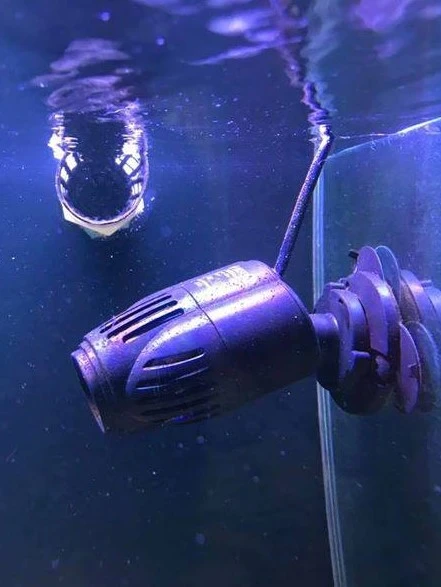8 Benefits Of Wavemaker For Clownfish

Water flow plays a crucial role in the health and well-being of clownfish. Understanding the advantages of water flow in their natural habitat allows us to create an aquarium setup that closely resembles their preferred conditions, guaranteeing their happiness and vitality. In this blog post, I will share my personal experiences and the insights I’ve gathered from extensive research.
So, what exactly is a wavemaker? In simple terms, it’s a device designed to generate water flow and replicate the ebb and flow of ocean currents within your tank. By recreating these natural patterns, wavemakers ensure that every corner of your aquarium receives the essential circulation required.
Benefits Of Wavemaker For Clownfish

Enhanced Feeding And Nutrition
Wavemakers distribute food particles throughout the aquarium, ensuring better nutrition for clownfish. As the Wavemaker generates gentle currents, it helps disperse the food evenly, preventing it from settling in one area. This ensures that all clownfish have access to food, even those that may be less dominant or slower swimmers.
Natural Feeding Experience
By mimicking natural feeding patterns, wavemakers help stimulate the clownfish’s instinct to search for and consume food, promoting a more natural feeding experience. In the wild, clownfish rely on ocean currents to carry food to them. By replicating these currents in the aquarium, wavemakers encourage clownfish to actively forage and hunt for their food, resulting in improved mental stimulation and overall nutrition.
Exercise And Muscle Development
Controlled water flow created by wavemakers encourages clownfish to swim actively, providing essential exercise. With a wavemaker, the water in the aquarium is constantly in motion, requiring clownfish to swim against the currents to maintain their position. This sustained swimming activity helps them build muscle strength and endurance. The increased physical activity not only strengthens their muscles but also makes them less prone to diseases.
Improved Water Quality
Efficient water flow is essential for maintaining optimal water quality in your aquarium. In an aquarium, waste particles can settle at the bottom or in dead spots without proper water movement, leading to poor water quality. Wavemakers help create a flow that reaches all tank areas, ensuring waste is constantly carried toward filtration systems or removed during water changes. A wavemaker helps create a healthier and cleaner environment for your clownfish by facilitating proper waste removal and oxygenation.
Reduce The Risk Of Harmful Substances
By maintaining optimal water quality, wavemakers reduce the risk of harmful substances, such as ammonia and nitrites, which can negatively impact the health of clownfish. The consistent water circulation facilitated by wavemakers helps prevent the build-up of these harmful compounds, promoting a healthy and stable environment for clownfish. This, in turn, reduces the likelihood of stress-related diseases and supports the overall well-being of the fish.
Stress Reduction
Appropriate water movement created by wavemakers helps reduce stress levels in clownfish, mimicking their natural habitat conditions. Clownfish are adapted to living in the ocean, where they experience gentle currents and water movement. Wavemakers simulate these conditions, providing a familiar and comforting environment for clownfish in captivity.
Plus, reduced stress levels lead to better coloration and improved immune function. When clownfish are less stressed, their colors are more vibrant, and they exhibit their natural patterns more prominently. A lower stress level also helps boost their immune system, making them more resistant to diseases and infections.
Oxygenation
Proper oxygenation is crucial for your clownfish. A wavemaker creates water movement that promotes gas exchange at the water’s surface, facilitating oxygen intake and releasing harmful gasses. This constant supply of oxygen helps maintain optimal oxygen levels, ensuring the health and vitality of your clownfish.
The Symbiotic Relationship of Clownfish & Anemones
Water flow also plays a crucial role in sustaining and augmenting the symbiotic relationship of Clownfish and Anemones. Anemones are delicate creatures that rely on water movement to bring nutrients and oxygen to their tissues.
A well-designed water flow pattern created by a wavemaker ensures that the anemone’s tentacles sway gently, mimicking the natural ocean currents. This gentle dance promotes the anemone’s health and vitality and provides a stimulating and enriching environment for the clownfish.
3 Things To Keep In Mind While Using A Wavemaker
- Customize wavemaker settings to suit the specific needs of your clownfish and aquarium because a high-pressure wavemaker can increase the stress levels of clownfish due to excessive water currents. So, adjust the intensity, duration, and pattern of water flow to simulate the natural conditions your clownfish thrive in.
- When choosing a wavemaker, opt for quiet and energy-efficient models to maintain a peaceful environment for your clownfish.
- The current created by a wavemaker may scatter clownfish food, making it challenging for the fish to locate and consume it, as the water currents can pull the food away into the filter. You can switch off your wavemakers while feeding your clownfish.
Final Thoughts
By carefully selecting and customizing a wavemaker to suit the specific needs of your clownfish, you can create an optimal aquatic environment that closely resembles their natural habitat. This not only ensures their physical health but also promotes their natural behaviors and contributes to their overall happiness.
You Might Also Be Interested In Reading
How To Reduce Clownfish Aggression?
Frequently Asked Questions
Yes, clownfish can potentially get caught in a wave maker’s propeller. However, a healthy fish should be capable of swimming away from the wave maker without harm. You can also use nets or foam covers to prevent the fish from swimming into the propeller during brief moments when it stops.
A wavemaker benefits clownfish by promoting natural feeding patterns, exercise, waste management, and stress reduction.
Clownfish and anemones share a symbiotic relationship where clownfish find shelter and protection among the anemone’s tentacles, while clownfish provide food and nutrients to the anemone.
